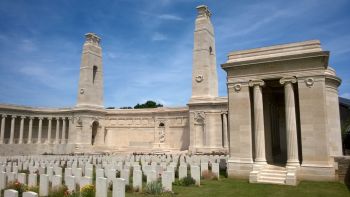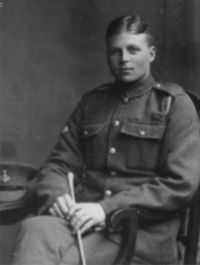|
|
| Home Topics Memorials Miscellany Transcripts References Family History Glossary Latest Beeston Blog About us | Site Search |
|
From 1916 onwards, conscription into the armed forces had become compulsory for all single men when reaching the age of 18, and they would then be eligible to be sent abroad on reaching age 19. Accordingly, Thomas William enlisted in March 19176 with the Essex Regiment and, after training, probably by the late summer of 1917, he would have been held in reserve to await his 19th birthday when he was eligible to be sent abroad. Although we have no precise record of the date, it is likely that he had joined 2nd Battalion Essex Regiment, part of 12th Brigade of 4th Division, in France by the early months of 1918. It is therefore, very likely that he took part in the series of desperate battles that began on 21st March 1918 when the enemy launched its Spring Offensive from the Hindenburg Line with the objective of ending the war before American troops and resources could tilt the balance towards the Allies. Although the enemy was eventually stopped, this was a desperate time during which those units involved - including 2nd Essex - suffered large casualties. At the end of August 1918 the battalion took up a position in the trenches at Eterpigny, east of Arras as an early part of the Allies' Hundred Days Offensive which was eventually to end the First World War. Its main attack on the 2nd of September was successful but it suffered about 50 casualties7. Sadly, Private Riley was amongst the 20 men killed. Private Riley's body was never identified and he is commemorated on the Vis-en-Artois Memorial to the Missing which stands as the back drop to the Vis-en-Artois British Cemetery, situated to the west of Haucourt on the Arras/Cambrai road, about 10 kilometres south-east of Arras. The Memorial bears the names of over 9,000 men who fell in the period from 8 August 1918 to the date of the Armistice in the Advance to Victory in Picardy and Artois, between the Somme and Loos, and who have no known grave. They belonged to the forces of Great Britain and Ireland and South Africa while the Canadian, Australian and New Zealand forces are commemorated on other memorials to the missing. The Memorial consists of a screen wall in three parts. The middle part of the screen wall is concave and carries stone panels on which names are carved. It is 26 feet high flanked by pylons 70 feet high. The Stone of Remembrance stands exactly between the pylons and behind it, in the middle of the screen, is a group in relief representing St George and the Dragon. The flanking parts of the screen wall are also curved and carry stone panels carved with names. Each of them forms the back of a roofed colonnade; and at the far end of each is a small building8. Private Riley was posthumously awarded the British War Medal and the Victory Medal9. His financial effects of £7 4s 8d were paid to his mother on 27 January 1919, for distribution within the family. His War Gratuity of £6 10s was paid to her on 10 December 1919.10. By this time, the family had moved to live at 36 Trafalgar Road, Beeston11, it being very conveniently situated for the several members of the family who were then working at Ericssons Telephone
works and some were to continue to do so. In 1939, Nellie Elizabeth Riley, who never married. was living alone at 36 Trafalgar Road and was still working at Ericssons as a wirer of automatic telephone exchanges.
Her mother, Harriett has been identified as living there up to 1936 but, although she has not been found in the 1939 Registration, she appears to have died in Basford Registration District (of which Beeston was
part) in 1956. aged 8912. Footnotes 1The photograph of the Vis-en-Artois Memorial is from the Commonwealth War Graves Commission website. (http://www.cwgc.org) 2His birth was registered in Nottingham Registration District in Q4/1898 (Ref 7b 298). His birthday is recorded as 10th October when he joined the Boys Brigade in September 1909, although his declared age of 12 appears to be about a year overstated. 3They were married at St Thomas' Church, Bethnal Green, London on 4 March 1889. 4Nottingham: 1901 Census, Piece 3165 Folio 81 5Beeston, Notts: 1911 Census, Piece 20432, RD429, SD3, ED7, Sched 74. No 28 was part of Tewkesbury Row Thomas Williams's siblings were Frederick Arthur (1889-1978), Charles (b. 1892), Hannah Harriett (1894-1989), Nellie Elizabeth (1902-1987), Ethel May (1904-1925) and Bertie William (1907-1992). 6As his Army Service Record has not survived, his month of enlistment has been calculated from the amount of his War Gratuity. 7Details the battalion's deployment in 1918 is from the battalion war diary. 8This description of the Vis-en-Artois Memorial is based on that the Commonwealth War Graves Commission website. (http://www.cwgc.org) 9Details from Thomas William's Medal Card and his Medal Roll entry - available on ancestry.com. 10Details from his entry in the Army Register of Soldiers' Effects, 1901-1929 - available on ancestry.com. 11This address was declared by (Bertie) William when he joined the Boys Brigade in August 1918. 12Family details from standard genealogy sources including the 1939 Registration and Electoral Rolls. |
|
|||||||||||
|
|
|||||||||||||

 Thomas William Riley was born in Nottingham in 18982, the fifth of seven surviving children of Frederick Joseph (b. 1862, West Ham, London) and
Harriett Riley (b. c1867, Swindon, Wiltshire née Washbourne)3. After Frederick and Harriett married in 1889, Frederick worked, apparently
with variable success, as a musician, sometimes having to take labouring jobs to try to make things meet. By 1898, when Thomas William was born, the family
had moved to Nottingham and were living at 10 Scarcliffe Terrace, Nottingham in 19014. In 1908, Frederick Joseph died, aged 474, leaving
Harriett with four children under 10. By 1911, she and her family had moved to Beeston and were living at 28 Nether Street with Thomas William attending the
nearby Nether Street School. Happily, her two eldest sons had found work at Ericssons telephone works in the town5. It seems likely that Thomas William
also found a job at Ericssons when he left school.
Thomas William Riley was born in Nottingham in 18982, the fifth of seven surviving children of Frederick Joseph (b. 1862, West Ham, London) and
Harriett Riley (b. c1867, Swindon, Wiltshire née Washbourne)3. After Frederick and Harriett married in 1889, Frederick worked, apparently
with variable success, as a musician, sometimes having to take labouring jobs to try to make things meet. By 1898, when Thomas William was born, the family
had moved to Nottingham and were living at 10 Scarcliffe Terrace, Nottingham in 19014. In 1908, Frederick Joseph died, aged 474, leaving
Harriett with four children under 10. By 1911, she and her family had moved to Beeston and were living at 28 Nether Street with Thomas William attending the
nearby Nether Street School. Happily, her two eldest sons had found work at Ericssons telephone works in the town5. It seems likely that Thomas William
also found a job at Ericssons when he left school.